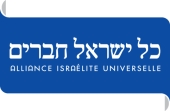Hacham Abraham Haim Naeh was born to Moussia and Rabbi Menachem Mendel in 1890, in Hebron. He studied Torah with his father, who was one of the leaders of the Chabad Hassidic sect in Israel and headed the Magen Avot yeshiva in Hebron, founded by Hebron Chief Rabbi Hacham Hizkiyahu Medini, known as the Sdeh Hemed. He entered the Magen Avot yeshiva in 1901 and in 1905 moved with his family to Jerusalem, where he studied at the Ohel Moshe and Torat Haim yeshivas and was ordained to the rabbinate by Rabbi Yitzhak Yeruham Diskin. He married Deborah Foenigstein at about that time, and the couple had nine children.
In 1910, Hacham Abraham Haim Naeh traveled to Lubavitch, where he met with the fifth Lubavitcher Rebbe, Rabbi Sholom DovBer Schneersohn. In 1911 he reached Bukhara as an emissary and settled in Smarakand, Uzbekistan. He authored Hanoch LaNa'ar for Bar Mitzvah boys, on halakhot regarding Tefillin and written in the Bukhari language, during that period.
In 1914, he returned to the Land of Israel but as a result of the outbreak of World War I, and because of his foreign citizenship, was expelled to Egypt - as were numerous other Jews. He then jointly established the Yeshivat Eretz Israel yeshiva for expatriates with Hacham Nissim Nachum. He headed the yeshiva together with the sages of Alexandria – Hacham Raphael Mipergola, the city's rabbi, and Hacham Abraham Avichzer, Head of the Rabbinic Court. It was during this period that he wrote Shnot Haim, on practical halakhot, which was translated into Arabic. He returned to Jerusalem at the end of the war, where he served as the Eidah HaHaredit's scribe and Rabbi of the Bukhari neighborhood.
Hacham Abraham Haim Naeh was one of the heads of the Chabad kollel in Israel. In 1921, he re-established the Torat Emet yeshiva on Me'ah She'arim Street. In 1924, he accompanied Rabbi Yosef Chaim Sonnenfeld, rabbi of the Eidah HaHaredit, to the latter's meeting with King Abdallah of Jordan. In 1929, he accompanied the sixth Lubavitcher Rebbe, Rabbi Yosef Yitzchak Schneersohn during his visit to the Land of Israel and to his meeting with Rabbi Abraham Isaac HaCohen Kook, Israel's Ashkenazi Chief Rabbi at that time.
During the period of the 1936 riots, his son was killed and two of his daughters injured when the family was murderously attacked at Sha'ar Hagay on their way back from a brother's wedding in Tiberias. His wife died, heartbroken, in 1938.
In 1944, the Eidah HaHaredit separated from Agudat Israel on the basis of their different approaches to the future State of Israel. Hacham Abraham Haim Naeh sided with the Agudat Israel position, was among the founders of its Kashrut Committee, and participated in the Mo'etzet Gedolei HaTorah Rabbinic Council.
His [halakhic] method that minimalized measures and quantities became widespread. Despite that his position on the matter differed from that of the Hazon Ish, Rabbi Yishayahu Kerlitz, leading sages of his generation and those that followed agreed with him. He publicized his method in Shiurei Torah, Shiur Mikve, Shiur Zion and Kuntrass HaShiurim.
Hacham Abraham Haim Naeh passed away on 20 Tammuz 5714 (1954) and was buried on Har Hamenuhot in Jerusalem.
Additional works of his include Sefer Kuntrass HaHaliva – on milking cows on the Sabbath, and Divrei Tzeddek, on the controversy surrounding Rabbi Yaakov Yoseph Mepolana's book, which ends with an explanation of Midrash Rabba on Ecclesiastes. Many of his books remain in manuscript form.



